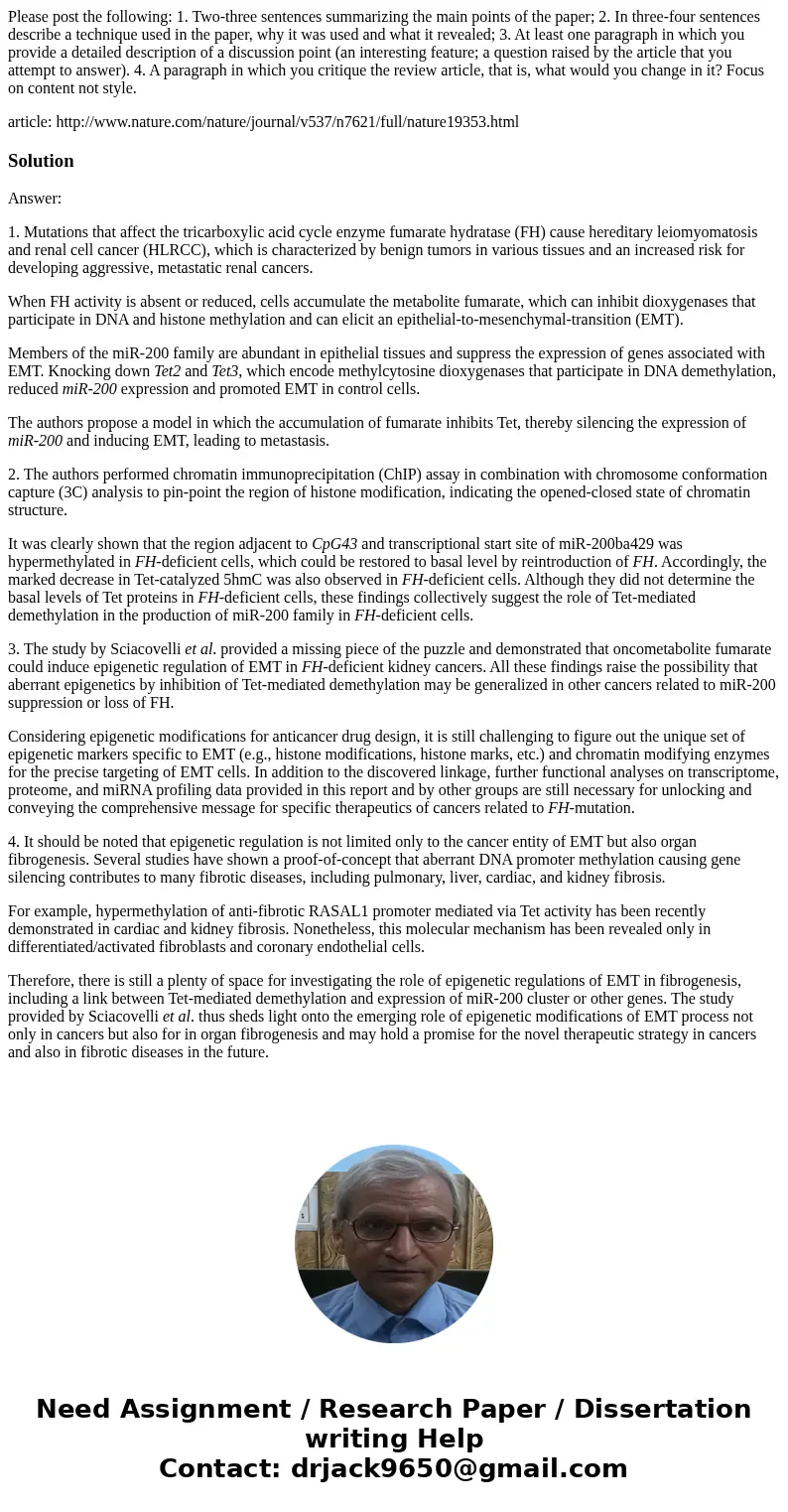Please post the following 1 Twothree sentences summarizing t
Please post the following: 1. Two-three sentences summarizing the main points of the paper; 2. In three-four sentences describe a technique used in the paper, why it was used and what it revealed; 3. At least one paragraph in which you provide a detailed description of a discussion point (an interesting feature; a question raised by the article that you attempt to answer). 4. A paragraph in which you critique the review article, that is, what would you change in it? Focus on content not style.
article: http://www.nature.com/nature/journal/v537/n7621/full/nature19353.html
Solution
Answer:
1. Mutations that affect the tricarboxylic acid cycle enzyme fumarate hydratase (FH) cause hereditary leiomyomatosis and renal cell cancer (HLRCC), which is characterized by benign tumors in various tissues and an increased risk for developing aggressive, metastatic renal cancers.
When FH activity is absent or reduced, cells accumulate the metabolite fumarate, which can inhibit dioxygenases that participate in DNA and histone methylation and can elicit an epithelial-to-mesenchymal-transition (EMT).
Members of the miR-200 family are abundant in epithelial tissues and suppress the expression of genes associated with EMT. Knocking down Tet2 and Tet3, which encode methylcytosine dioxygenases that participate in DNA demethylation, reduced miR-200 expression and promoted EMT in control cells.
The authors propose a model in which the accumulation of fumarate inhibits Tet, thereby silencing the expression of miR-200 and inducing EMT, leading to metastasis.
2. The authors performed chromatin immunoprecipitation (ChIP) assay in combination with chromosome conformation capture (3C) analysis to pin-point the region of histone modification, indicating the opened-closed state of chromatin structure.
It was clearly shown that the region adjacent to CpG43 and transcriptional start site of miR-200ba429 was hypermethylated in FH-deficient cells, which could be restored to basal level by reintroduction of FH. Accordingly, the marked decrease in Tet-catalyzed 5hmC was also observed in FH-deficient cells. Although they did not determine the basal levels of Tet proteins in FH-deficient cells, these findings collectively suggest the role of Tet-mediated demethylation in the production of miR-200 family in FH-deficient cells.
3. The study by Sciacovelli et al. provided a missing piece of the puzzle and demonstrated that oncometabolite fumarate could induce epigenetic regulation of EMT in FH-deficient kidney cancers. All these findings raise the possibility that aberrant epigenetics by inhibition of Tet-mediated demethylation may be generalized in other cancers related to miR-200 suppression or loss of FH.
Considering epigenetic modifications for anticancer drug design, it is still challenging to figure out the unique set of epigenetic markers specific to EMT (e.g., histone modifications, histone marks, etc.) and chromatin modifying enzymes for the precise targeting of EMT cells. In addition to the discovered linkage, further functional analyses on transcriptome, proteome, and miRNA profiling data provided in this report and by other groups are still necessary for unlocking and conveying the comprehensive message for specific therapeutics of cancers related to FH-mutation.
4. It should be noted that epigenetic regulation is not limited only to the cancer entity of EMT but also organ fibrogenesis. Several studies have shown a proof-of-concept that aberrant DNA promoter methylation causing gene silencing contributes to many fibrotic diseases, including pulmonary, liver, cardiac, and kidney fibrosis.
For example, hypermethylation of anti-fibrotic RASAL1 promoter mediated via Tet activity has been recently demonstrated in cardiac and kidney fibrosis. Nonetheless, this molecular mechanism has been revealed only in differentiated/activated fibroblasts and coronary endothelial cells.
Therefore, there is still a plenty of space for investigating the role of epigenetic regulations of EMT in fibrogenesis, including a link between Tet-mediated demethylation and expression of miR-200 cluster or other genes. The study provided by Sciacovelli et al. thus sheds light onto the emerging role of epigenetic modifications of EMT process not only in cancers but also for in organ fibrogenesis and may hold a promise for the novel therapeutic strategy in cancers and also in fibrotic diseases in the future.

 Homework Sourse
Homework Sourse